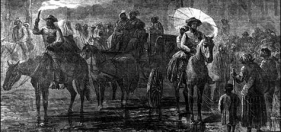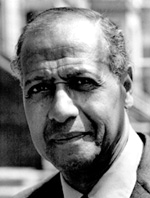by Sandy | Jul 10, 2016 | Arts, Entertainment and Music, Blogroll, Books, Culture, Education, Events, Learning

Spoken word events, a forum for Caribbean writers, over 200 exhibit booths, music, panel discussions and children’s activities will be on hand at the Harlem Book Fair. It’s a great way to spend a Saturday in the city.
“The vision of the Harlem Book Fair is to partner with local 
and national leadership organizations under the banner of literacy
awareness, affirming HBF as the nation’s largest African American
literary event celebrating family literacy, community empowerment,
and community cooperation. “
18th Annual Harlem Book Fair
Saturday, July 16, 2016
SCHOMBURG CENTER FOR RESEARCH IN BLACK CULTURE
515 Lenox Avenue, West 135th Street,, NYC
Info:
Tel:914.231.6778 / Tel: 212.491.2200
***
by Sandy | Mar 20, 2016 | Blogroll, Culture, Exhibits, Museums
At the Museum of Fine Arts, Houston: “The Cradle”, John Biggers

“Statements: African American Art from the Museum’s Collection is the latest in a series of focused installations highlighting unique areas of strength in the collection of the Museum of Fine Arts, Houston. Featuring artists who have shaped the course of American art across eight decades, Statements brings together more than 40 works in a wide range of media, from Richmond Barthé’s iconic Feral Benga of 1935 to Mark Bradford’s Circa 1992, created in 2015.”
Some of the artists included in the exhibit: John Biggers, Elizabeth Catlett, Melvin Edwards, Loretta Pettway Louise Ozell Martin, Gordon Parks, Ernest C. Withers Mequitta Ahuja, Nick Cave, Glenn Ligon, and Kara Walker.
“Statements: African American Art”
Until April 24, 2016
Museum of Fine Arts, Houston, 1001 Bissonnet St, Houston, TX
(Image: The Cradle, John Biggers, 1950, Conté crayon on paper board)
***

by Bob Martin | Mar 2, 2016 | Books, Creativity, Education, Photograhy
Today I got the chance to meet Stephen Marc again and to see his incredible book of photo montages and composites “Passage on the Underground“. Talking with Stephen is inspiring, full of lessons and new understanding about the history of the African in America.

OLYMPUS DIGITAL CAMERA
While on his Underground Railroad explorations, Marc’s experiences include:
- Discovering a long-lost false grave that was the exit from an escape tunnel for fleeing slaves. Though the exit had never been found by the local Underground Railroad historians, Marc’s fresh eye led him to what is now believed to be the solution to a 100-year-old mystery.
- Visiting a house long ago owned by a conductor on the Underground Railroad, Marc talked his way in to photograph it during renovations, because he knew the amazing story of two escaped slaves who hid in the rafters, right above the heads of their would-be captors, who searched the house and left without finding them.
- A connection with a New York community college in Jamestown, home of Catherine Harris, a conductor on the Underground Railroad. When Jamestown Community College attempted to purchase some of Marc’s work that was on display, he volunteered to create a custom piece that reflected the community’s connection to the Underground Railroad…. Passage on the Underground
Stephen shared with us a little about his next project. He is a man on a mission. He is available to speak with young people, especially middle graders, about Slavery, The Underground Railroad and African American History in General. He can be contacted via Arizona State University in Tempe AZ
(Originally posted on 2/6/2010)
***

by Sandy | Aug 27, 2015 | Art, Artist, Blogroll, Culture, Photograhy

Roy DeCarava, 1919 – 2009, left behind a treasure trove of black and white images spanning over 6 decades. He captured images of the famous of the day, Paul Robson, John Coltrane, however, his pictures were usually of the regular inhabitants of Harlem and their everyday life. DeCarava said that “black people in America were not viewed as worthy subject matter” for art but rather were usually “portrayed either in a superficial or a caricatured way or as a problem.” … he wanted to achieve “a creative expression,” not a “documentary or sociological statement.”
Harlem born DeCarava encouraged and influenced the work of many black photographers over the years. He was the first African American to win the Guggenheim Fellowship in 1952 and was awarded a National Medal of Arts in 2006. He collaborated with poet Langston Hughes, another Harlem native, for the acclaimed book, “The Sweet Flypaper of Life” in 1955.
(Image: “Man Coming Up the Stairs”, 1952)
***
by Bob Martin | Aug 6, 2015 | Art, Artist Residencies, Culture, Photograhy

nyc subway “What the future looks like…” Photo Cybel Martin
Art rejuvenates cities and gives them new vitality. Large cities are where you get to see what the future is like. Cities are the most fun just before they are recognized as being fun, before the big bucks move in trying to buy the culture up. Culture is like an ocean, it goes where it wants and ignores the concept of money.
Cities are transformational experiences
Public transportation, like New York’s Subway is the best way to get around in a city, where your imagination is brought to life, where you can hear your own heart beating in sync with everyone else’s and where you are confronted with everything that is not you. Cities are where you can see the diversity of our young people and imagine the future.
Culture is like an ocean, it goes where it wants and ignores the concept of money.
A strong artist community can bring a city back to life.
Detroit is one of those cities that is poised for a creative comeback. Everything is in place. Those that left could not take with them the city’s creative possibilities. Those that stayed have to be hungry about making a positive difference otherwise they too must leave and make space for the dreamers.
***

by Sandy | Jun 14, 2015 | Blogroll, Books, Culture, Writers
Africa: Altered States, Ordinary Miracles, by Richard Dowden
Do you ever get the feeling that westerners do not understand Africa at all? Even after so many years of subjugation and interference, Europeans still don’t have a clue about the people they colonized. They, along with we Americans, black or white, don’t really get how a continent beset by such poverty, misery, cruelty and waste can still produce men and women who keep going. Putting one foot in front of the other, bringing children into their world and expecting good things to happen – somewhere/sometime.

English correspondent Richard Dowden attempts to explain it in his book, Africa: Altered States, Ordinary Miracles. He proposes that the African has a different approach and reaction to life, a different appreciation:
“Terrible times produce strength. Grief enhances joy. Death invigorates living…Africa lives with death and suffering and grief every day, but to be alive is to talk and laugh, eat and drink – dance”.
Africa: Altered States, Ordinary Miracles, by Richard Dowden
btw: The author also thinks that “only Africans can develop Africa.” (Hmmmm.)
***










